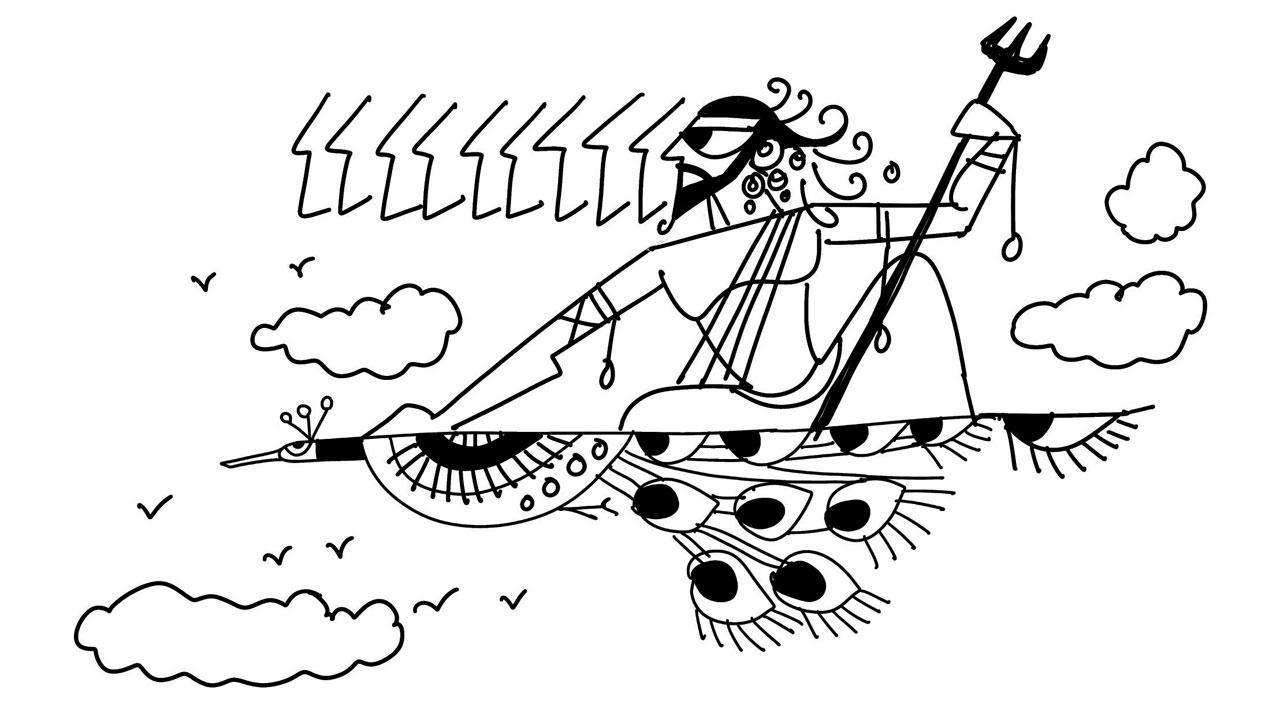On this flying vehicle, the carpenter’s son not only went to school, impressing his class, but also on many adventures, eventually marrying a princess.

Illustration/Devdutt Pattanaik
 Pushpak Viman of Ravana was shaped like a peacock. The origin of this idea comes from an old Sri Lankan folk tale. Since a headman gave his son a horse-drawn cart to go to school, a carpenter’s son pestered his father for a vehicle. His father created a wooden peacock (dandu-monara, in Sinhalese), fuelled with mercury, that could fly. On this flying vehicle, the carpenter’s son not only went to school, impressing his class, but also on many adventures, eventually marrying a princess.
Pushpak Viman of Ravana was shaped like a peacock. The origin of this idea comes from an old Sri Lankan folk tale. Since a headman gave his son a horse-drawn cart to go to school, a carpenter’s son pestered his father for a vehicle. His father created a wooden peacock (dandu-monara, in Sinhalese), fuelled with mercury, that could fly. On this flying vehicle, the carpenter’s son not only went to school, impressing his class, but also on many adventures, eventually marrying a princess.
Nowadays, in hotels and bars around Colombo, Sri Lanka, one finds images of this flying wooden peacock, but it is not described as a creation of a carpenter. It is described as Ravana’s Pushpaka Vimana. In a recent conference, it was argued that Ravana invented the aeroplane long before the Wright brothers. As in India, mytho-fiction writers are arguing that Ravana was a great king of ancient Sri Lankan—an expert in medicine, engineering, martial arts—whose history has been deliberately erased by later Buddhist chronicles introduced by Indians. The older “Hala-Yakha” civilisation was full of wonderful technologies. In 2019, Sri Lanka launched its first satellite. It was named Raavana 1.
Travel guides creatively identify various natural formations of the island as the Ramayana trail. For example, the city of Wariyapola is now believed to be Ravana’s airport as Wari means “wind” and pola means “place”. Windy place is now seen as the place of landing for the wooden peacock of Ravana, alarming rationalists. Pseudoscience is now the rage in the island nation as in the rest of the world.
Sita Eliya, a town that appeared only when Tamil immigrants began working in local tea estates, now has a Sita temple that attracts hundreds of eager Indian tourists. Stone impressions are considered Hanuman’s footprints. The black soil is considered to be the ash left behind after Lanka was set aflame. The 5th century ruins of Sigiriya fortress are now marketed as Ravana’s palace. It has done wonders for the travel industry.
The island was identified as Ravana’s Lanka primarily after the 10th century, when Chola kings invaded Sri Lanka, plundered its capital, Anuradhapura, and conquered parts of it, mainly to control its copper mines and sea trading routes. Then, around the 15th century, many Tamils migrated to Sri Lanka after Madurai became a Muslim Sultanate. That is when Ramayana became familiar to the island nation. Later, folk Ramayana came with Tamil labourers, who were also influenced by the political Tamil Dravidian movement, that also saw Ravana as a great leader and Ram as an Aryan invader.
The idea of wooden mechanical devices fuelled by mercury that could fly is an ancient one Between the 8th and 10th century, we find such references in India, as well as in Arabia. In Arabia, it was said that King Solomon impressed the Queen of Sheba, by using such a device. In India, Mihir Bhoja writes about such devices in his book, Samarangana Sutradhara. These were obviously fabulous folktales meant to impress people. Other than 21st century “vimana-shastris”, no one takes such ideas to be anything but fiction. But it does fuel pride in an imagined past, which translates into votes, which is all that matters to the politician.
The author writes and lectures on the relevance of mythology in modern times. Reach him at devdutt.pattanaik@mid-day.com
 Subscribe today by clicking the link and stay updated with the latest news!" Click here!
Subscribe today by clicking the link and stay updated with the latest news!" Click here!










